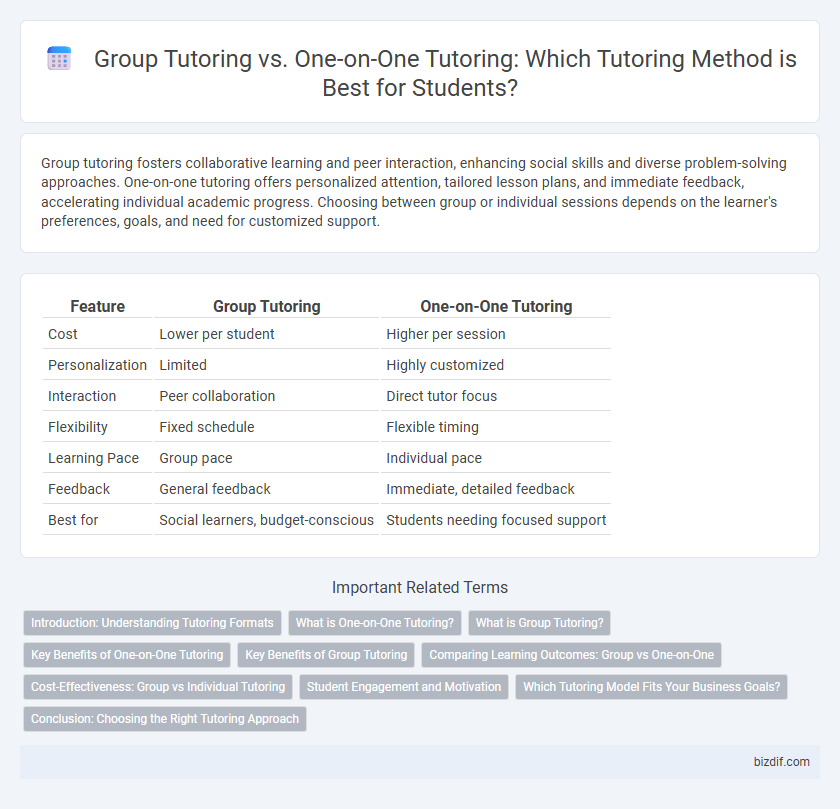Group tutoring fosters collaborative learning and peer interaction, enhancing social skills and diverse problem-solving approaches. One-on-one tutoring offers personalized attention, tailored lesson plans, and immediate feedback, accelerating individual academic progress. Choosing between group or individual sessions depends on the learner's preferences, goals, and need for customized support.
Table of Comparison
| Feature | Group Tutoring | One-on-One Tutoring |
|---|---|---|
| Cost | Lower per student | Higher per session |
| Personalization | Limited | Highly customized |
| Interaction | Peer collaboration | Direct tutor focus |
| Flexibility | Fixed schedule | Flexible timing |
| Learning Pace | Group pace | Individual pace |
| Feedback | General feedback | Immediate, detailed feedback |
| Best for | Social learners, budget-conscious | Students needing focused support |
Introduction: Understanding Tutoring Formats
Group tutoring fosters collaborative learning through peer interaction, enhancing critical thinking and social skills in a shared environment. One-on-one tutoring offers personalized instruction tailored to individual learning styles and pace, promoting focused skill development and targeted feedback. Choosing the right format depends on student needs, learning goals, and preferences for social engagement versus individualized attention.
What is One-on-One Tutoring?
One-on-one tutoring delivers personalized instruction tailored to the student's individual learning style, pace, and needs, ensuring targeted skill development and focused attention. This method fosters a deeper understanding of subject matter through immediate feedback and customized lesson plans. Students often experience increased motivation and confidence due to the direct interaction and support from their tutor.
What is Group Tutoring?
Group tutoring involves instructional sessions where one tutor works simultaneously with multiple students, fostering collaborative learning and peer interaction. This method often enhances problem-solving skills and communication by encouraging students to engage in discussions and share diverse perspectives. Group tutoring is cost-effective and promotes a dynamic educational environment, contrasting with the personalized focus of one-on-one tutoring.
Key Benefits of One-on-One Tutoring
One-on-one tutoring provides personalized instruction tailored to a student's unique learning style and pace, leading to higher academic performance and deeper understanding of subjects. Students receive immediate, targeted feedback and support, which enhances skill retention and confidence. This individualized approach fosters stronger tutor-student relationships, promoting motivation and long-term educational success.
Key Benefits of Group Tutoring
Group tutoring fosters collaborative learning by enabling students to share diverse perspectives and problem-solving strategies, enhancing critical thinking skills. It offers a cost-effective solution, making quality education accessible while promoting social interaction and communication skills among peers. Exposure to group dynamics in tutoring sessions prepares students for teamwork in academic and professional settings.
Comparing Learning Outcomes: Group vs One-on-One
Group tutoring encourages collaborative learning, enhancing communication skills and exposing students to diverse perspectives, which can lead to improved problem-solving abilities. One-on-one tutoring offers personalized instruction tailored to individual learning styles and paces, resulting in higher retention and faster comprehension of complex subjects. Studies show that while group sessions boost social and interactive skills, one-on-one tutoring typically yields stronger academic performance and more targeted mastery of material.
Cost-Effectiveness: Group vs Individual Tutoring
Group tutoring offers a more cost-effective solution by distributing the tutor's fee among multiple students, reducing the per-student expense compared to one-on-one sessions. Individual tutoring provides personalized attention but often comes at a higher hourly rate, making it less affordable for families on a budget. Balancing cost with learning needs, group tutoring maximizes resource efficiency while one-on-one ensures tailored instruction.
Student Engagement and Motivation
Group tutoring fosters collaborative learning environments that enhance student engagement by encouraging peer interaction and idea exchange, which can boost motivation through social support and shared goals. One-on-one tutoring offers personalized attention tailored to individual learning styles, increasing motivation by addressing specific challenges and providing immediate feedback. Both methods can effectively improve motivation and engagement but differ in social dynamics and customization levels.
Which Tutoring Model Fits Your Business Goals?
Choosing between group tutoring and one-on-one tutoring depends on your business goals, such as scalability, personalized attention, and revenue growth. Group tutoring allows for higher student capacity and lower price points, making it ideal for businesses aiming to expand quickly and increase market reach. One-on-one tutoring offers tailored learning experiences and higher client satisfaction, fitting businesses focused on premium services and intensive skill development.
Conclusion: Choosing the Right Tutoring Approach
Selecting the ideal tutoring approach depends on the learner's goals, budget, and preferred interaction style. Group tutoring fosters collaboration and diverse perspectives, enhancing social learning, while one-on-one tutoring offers personalized attention and tailored instruction for accelerated progress. Prioritizing individual learning needs and educational objectives ensures the most effective tutoring method is chosen.
Group Tutoring vs One-on-One Tutoring Infographic

 bizdif.com
bizdif.com